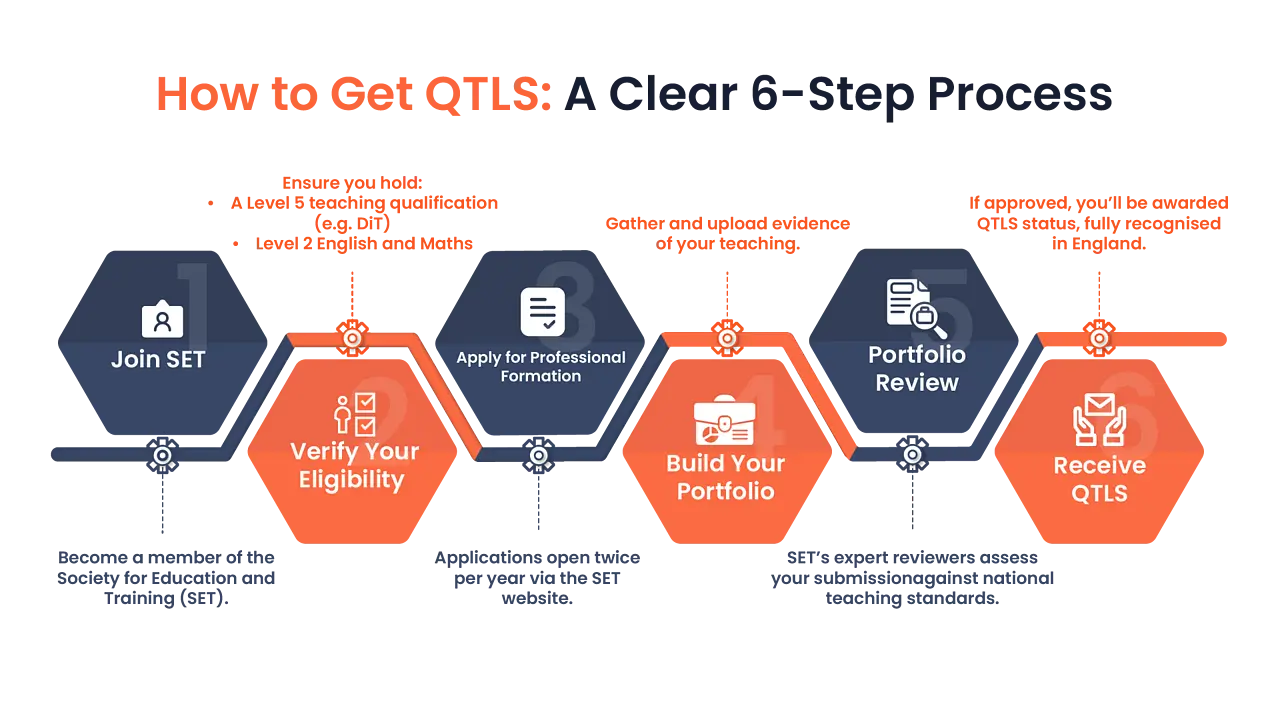Qualified Teacher Learning and Skills (QTLS) status is a nationally recognised benchmark to become a fully qualified teacher in the Further Education (FE) sector. It is not a qualification itself but a status you achieve by completing a process called Professional Formation.
Key Takeaways:
- QTLS is a professional status awarded in England that confirms you meet national teaching standards, recognised teaching benchmark.
- The eligibility criteria for QTLS include a Level 5 teaching qualification, Level 2 English and maths, active SET membership, and employment in an appropriate teaching role.
- DiT is a comprehensive qualification that provides the most cost-effective way to achieve QTLS while showing your capability to teach in post-16 education.
QTLS offers a credible and structured route for learners looking to formalise their teaching role in the FE sector or access wider opportunities in the education sector. To be eligible to apply for the status, you are required to have the proper teaching qualification and evidence of your practice. This blog will help you understand the pathway through which you can achieve QTLS status.

What is QTLS Status?
Qualified Teacher Learning and Skills (QTLS) is a nationally recognised status in England. It is earned through professional formation, which enables you to show your progression and commitment to excellence within the Further Education (FE) and Skills sector.
The Society for Education and Training (SET) awards QTLS status to teachers. SET is a professional membership body for practitioners in the post-16 education and training sector. It operates under the Education and Training Foundation (ETF), the national body responsible for improving teaching and leadership in further education.
Moreover, QTLS holders will be issued with a Teacher Reference Number (TRN). This TRN will appear on the Department for Education’s (DfE’s) central record of qualified teachers managed by the Teaching Regulation Agency, recognising you as a qualified teacher.
What are the Eligibility Criteria for QTLS Status?
Before applying for QTLS, you must meet the requirements set by the Society for Education and Training (SET). SET has designed the eligibility criteria in collaboration with the Department for Education (DfE) and the FE and Skills sector.
This section outlines exactly what you need to have in place before you can submit your application.
Recognised Qualifications
To apply for QTLS, you must hold a minimum of a Level 5 or higher teaching qualification. The most widely accepted and flexible qualification is the Level 5 Diploma in Teaching (FE and Skills), which is a comprehensive, cost-effective and preferred teaching qualification to teach in Further Education. This qualification comprehensively prepares individuals for roles that enable them to plan, deliver, and assess learning in post-16 education or Further Education, and is directly mapped to national teaching standards.
Obtaining a Diploma in Teaching is one of the most cost-effective ways to achieve QTLS. It is fast because the mode of learning is 100% online, meaning it will be entirely dependent on your learning time and capacity. With the theoretical work, you are required to complete 250 hours of work placement at two different locations under the supervision of two mentors (subject specialist and pastoral mentor). A minimum of ten formal observations, each lasting at least 45 minutes, must be conducted and verified by either a placement tutor or designated mentors.
Want QTLS? Start with the right qualification.
Enrol in our Level 5 Diploma in Teaching (FE and Skills) today.
Apply Now!

Along with a level 5 qualification, you must hold level 2 or above in literacy and numeracy equivalent to a minimum of GCSE Grade 4 (formerly Grade C) or above.
Additionally, if you teach all your subjects for fewer than five hours per week, you are required to hold at least one Level 3 or above subject-specific qualification. If you are teaching a subject-specific qualification for five hours or above per week, then you must also demonstrate that you have a minimum of five years’ teaching experience within FE and Skills, evidenced via a current CV.
Employment and Teaching Experience
To apply for QTLS, you must be employed in the FE and skills sector, teaching post-14 learners. You should be actively engaged in planning, delivering, assessing, and managing learning environments for post-14 learners, with at least 230 hours of teaching experience over a six-month period. You will be required to submit an employer agreement as part of your application portfolio.
SET Membership
You must be an active member of the Society for Education and Training (SET) before you can begin the QTLS application process. The membership status must be MSET (Member) or FSET (Fellow) before registering for Professional Formation. Being part of SET also gives you access to the platform where you will build and submit your QTLS portfolio, exhibiting your commitment to professional teaching standards in the sector.

How Long Does it Take to Get QTLS Status?
You can get your QTLS status after successfully completing a six-month period of professional formation. The validity of QTLS status is maintained through membership of the Society for Education and Training (SET).
What is the Fee Breakdown for the QTLS?
There are two main costs involved in the QTLS process. First, you’ll need to pay the annual SET membership fee, which is approximately £50 (non-refundable). This is a requirement before you can even begin your application procedure. Once your SET membership is active, you can apply for the Professional Formation Programme by paying an additional fee of £545.
You can check SET website for the most up-to-date figures.
When Can I Apply for QTLS?
You can apply for QTLS in the spring or autumn, as SET opens the application procedure twice a year. After your acceptance into the programme, the Professional Formation period runs for six months, during which you will complete and submit your portfolio. You are required to ensure that your teaching hours, documents, and support arrangements are all in place before applying.
Does QTLS status expire?
An active membership with the Society for Education is required to maintain the QTLS status. If you are a member of SET, your name will appear on both the SET Professional Status Register and the Department for Education’s (DfE) central record of qualified teachers, managed by the Teaching Regulation Agency (TRA).
If your SET membership lapses or is cancelled, your name will be removed from the Professional Status Register. While you’ll still appear in the Department for Education’s record, your QTLS will no longer be recognised as valid.
Final Thoughts
status is a formal recognition of your ability to meet national teaching standards and a step toward broader career opportunities. If you are already working in Further Education or planning to transition into a qualified teaching role, QTLS will enhance your credibility. The process isn’t complicated, but it does require the right qualifications, consistent teaching practice, and a commitment to reflective development. Starting with the Level 5 Diploma in Teaching (FE and Skills) gives you a clear, recognised route into eligibility.





